Document Manager
The Document Manager allows you to connect files, notes or other objects to any record in Standard ERP. These connected objects are sometimes known as "Attachments".
In the top right-hand corner of every record window, there is a [Document Manager] button. If a record has an Attachment, the button has the icon on the left, otherwise it has the icon on the right.

If you are using Mac OS X, the button has the following icons (again, the icon on the left signifies that an Attachment is present):

Click this button when you need to work with the Document Manager (or select 'Attachments' from the Record menu). The 'Document Manager' window will be opened: this is a list of objects currently attached to the record you are looking at:
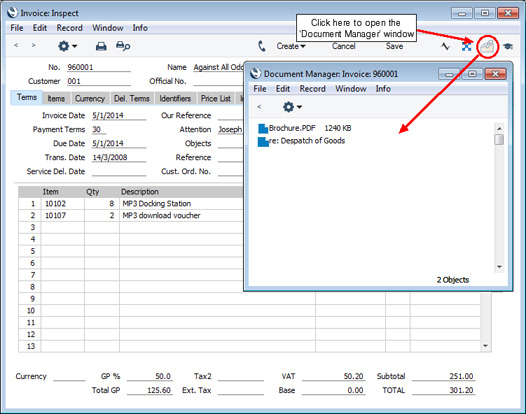
This window has its own Operations menu, which contains some functions to help you work with Attachments:
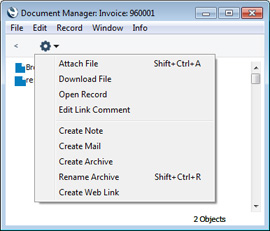
You must save a record at least once before you can add any Attachments to its Document Manager.
Attaching Files to Records
To attach a file to a record, open the record in question and click the [Document Manager] button. Select 'Attach File' from the Operations menu. An 'Open File' dialogue box will open, allowing you to locate the file to be attached. Find the file and click [Open]. The file will be attached to the record, and its filename will appear in the 'Document Manager' window. You can attach as many files as you like to a single record.
The 'Attach File' function attaches a file to a record by copying the file into a folder called "Attach" that is in the same folder as your Standard ERP application. In multi-user systems, the "Attach" folder should be on the server. This means that you will still be able to download and read the attached file, even after the original has been deleted. If you want to attach a large file to a record, make sure (using the disk space indicator in the 'About Standard ERP' window) that the hard disk containing your Standard ERP application has sufficient space. As the file is uploaded to the server, a progress indicator appears so that you can monitor its progress.
! | The "Attach" folder must be present in the folder containing your Standard ERP application if you want to attach files to records. Do not rename any of the files in the "Attach" folder. |
|
Reading Files
You can read a file that has been attached to a record in one of three ways:
- By double-clicking on the file in the 'Document Manager' window. The file will be saved in the "Tmp" folder in the folder containing your Standard ERP application, and it will then be opened using the appropriate helper application (not Mac OS X).
- By clicking on the file in the list of Attachments and selecting 'Download File' from the Operations menu. A 'Save File' dialogue box will be opened, asking you where the file is to be saved, and the file will then be saved to your hard disk. No attempt will be made to open it using a helper application. If you are using Mac OS X, you can double-click the file in the 'Document Manager' window as an alternative to selecting the 'Download File' function.
- By clicking on the file in the 'Document Manager' window and selecting 'Open Record' from the Operations menu. The file will be saved to the "Tmp" folder in the folder containing your Standard ERP application, and it will then be opened using the appropriate helper application.
If you open the file as described in steps 1 and 3 and then make changes to it, those changes will only be saved in the local copy of the file (in the "Tmp" folder in the folder containing your Standard ERP application). The file attached to the record will not be changed, so you may need to replace it with the revised version.
Attaching Notes or Comments to Records
You can attach notes or comments to records. To do this, open the record in question and click the [Document Manager] button. Select 'Create Note' from the Operations menu. A window will open, where you can type in your note.

Enter a Comment (text that will identify the note in the 'Document Manager' window) and click [Save] to save. You can attach as many notes as you like to a single record.
Reading and Changing Notes
You can read a note or comment that has been attached to a record in one of three ways:
- By clicking on the note in the 'Document Manager' window and selecting 'Open Record' from the Operations menu;
- By double-clicking on the note in the 'Document Manager' window; and
- By clicking on the note in the 'Document Manager' window and selecting 'Save' from the Record menu.
Whichever method you use, the note will be opened in its own window where you can read or edit it.
Printing Notes
A note or comment that has been attached to a record can be printed when you print the record. For example, a note that has been attached to an Invoice can be printed on the Invoice. This feature is included in the Invoice, Activity, Receipt Form, Payment Form, Reservation, Purchase Order, Order, Internal Sales Order, Quotation, Rental Quotation, Stock Movement and VAT Correction forms. If more than one note has been attached to a record, only the first note will be printed.
If you want notes and comments to be printed in this way, you should include the "Note" field in each of your Form Template designs:

It is recommended that you use the Word Wrap feature as shown in the illustration. Otherwise, long notes will be truncated when they are printed.
If you generally attach many notes to records, you can specify that the note with a specific Comment will be printed, not the first note. You will then need to ensure that every time you attach a note intended for printing to a record in a particular register, you always use the same Comment. For example, you may want to print a note about special offers on Invoices. Each time you attach a note to an Invoice, use the same Comment (e.g. "Special Offer"). Then, when adding the "Note" field to the Invoice Form Template, specify this Comment ("Special Offer" in the example) as the Field Argument:
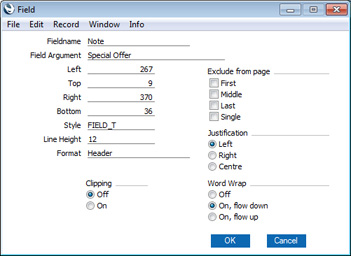
You can only include one "Note" field in a particular Form Template.
Form Template design in fully described here.
Changing the Names of Attachments
If you want to change the name of a file or note as it appears in the 'Document Manager' window, highlight it and select 'Edit Link Comment' from the Operations menu. A window opens where you can type in a new name.

Click [Save] to save and close the window, or [Cancel] if you don't want to save changes.
If the Attachment is a note, you can also change its name by double-clicking and editing the Comment in the 'Note: Inspect' window.
Attaching Reports to Records
To attach a report to a record, first print the report to screen, and open the record in question. The Button Bar of the report window contains a [Document Manager] button:

Drag this button to the 'Document Manager' window of the record or (Mac OS X only) to the [Document Manager] button of the record. The report will be attached to the record.
When you attach a report to a record, the report will first be printed to file and that file will be attached to the record. The report file is stored in the "Attach" folder that is in the same folder as your Standard ERP application. In multi-user systems, the "Attach" folder should be on the server. If you need to read the report later, you will effectively be reading the file, not producing the report again. The information it contains will be correct for the moment when it was originally produced, not for the moment when you are reading it. This may be useful if you have attached the report to a Mail for discussion with another member of staff. When you read the report later, it will be opened in a standard report window, so you can select 'Recalculate' from the Operations menu if you need to update the report to include the latest information in the database.
! | The "Attach" folder must be present in the folder containing your Standard ERP application if you want to attach reports to records. Do not rename any of the files in the "Attach" folder. |
|
Reading Reports
You can read a report that has been attached to a record in one of three ways. Whichever method you use, the report will be opened in a standard
report window.
- By double-clicking on the report in the 'Document Manager' window.
- By clicking on the file in the 'Document Manager' window and selecting 'Download File' from the Operations menu.
- By clicking on the file in the 'Document Manager' window and selecting 'Open Record' from the Operations menu.
Removing Attachments
To remove an attachment of any kind from a record, highlight it in the 'Document Manager' window and either press the Backspace key on your keyboard or select 'Clear' from the Edit menu.
Copying Attachments from one Record to Another
You can copy an Attachment of any kind from one record to another as follows:
- Open the record with the Attachment (the "source" record) and click its [Document Manager] button to open its 'Document Manager' window.
- Open the record that is to receive the Attachment (the "destination" record) and (not necessary if you are using Mac OS X) click its [Document Manager] button.
- Drag the Attachment from the source 'Document Manager' window to the destination 'Document Manager' window (or to the [Document Manager] button of the destination record (Mac OS X only)).
- Hold down the Shift key while dragging if you do not want to remove the Attachment from the source record.
Organising Attachments: Archives
When a record has many Attachments, you can organise them into Archives. An Archive is a folder that can contain Attachments of all kinds, including other Archives.
- Open the 'Document Manager' window.
- Select 'Create Archive' from the Operations menu. The 'Create Archive' window opens, where you can give the new Archive a name:

When you click the [Save] button, the new Archive will appear at the top of the 'Document Manager' window:
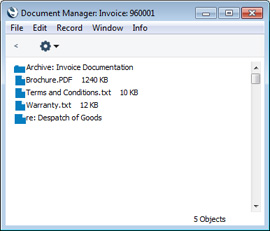
- Move the Attachments into the Archive by dragging and dropping onto it.
- If you want to work with an Attachment that is in an Archive, double-click the Archive. The contents of the Archive are then shown in the window, whose title changes to show the name of the Archive.
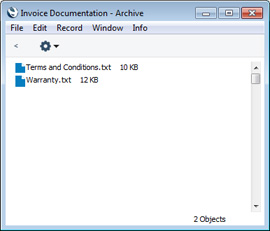
To go back to the top level (or previous level) list of Attachments, click the button with the arrow icon (located towards the top left-hand corner of the window):

- If you want to rename the Archive, first open it as described in step 4 above and then select 'Rename Archive' from its Operations menu.

Enter the new Name of the Archive and click [Save].
- You can remove an Attachment from an Archive in one of two ways. If you want the Attachment to remain attached to the record, drag it to the main list of Attachments or to another Archive. To remove the Attachment altogether, click on it and either press the Backspace key on your keyboard or select 'Clear' from the Edit menu.
- To remove an Archive, click on it in the main list of Attachments and either press the Backspace key or select 'Clear' from the Edit menu. You can only remove empty Archives. To empty an Archive, you must remove its contents item by item as described in step 6 above.
---
Go back to:
